Short Book Reviews
Hanna Kryszewska, Poland
Hanna Kryszewska is a teacher, teacher trainer, trainer of trainers. She is a senior lecturer at the University of Gdańsk, University SWPS, Sopot, and GUMed, Gdańsk. She is co-author of resource books: Learner Based Teaching, OUP, Towards Teaching, Heinemann, The Standby Book, CUP, Language Activities for Teenagers, CUP and a course book series for secondary schools: ForMat, Macmillan. She is also co-author of a video based teacher training course: Observing English Lessons. Hania is a trainer on Pilgrims Teacher Training courses and University of Oxford summer school for teachers. She is also the editor of HLT Magazine.
E-mail: hania.kryszewska@pilgrims.co.uk
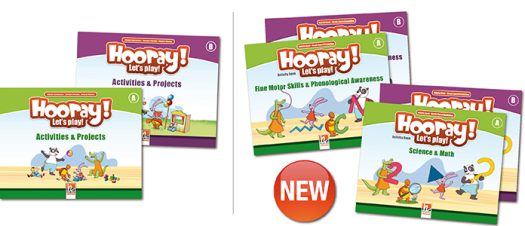
Hooray! Let’s play! Science and Maths. Activity book A. C. Aoun and N. S. Boukidjian. (2016) Helbling Languages. ISBN 978-3-99045-455-8, pp124. Hooray! Let’s play! Fine Motor Skills & Phonological Awareness. Activity book A. C. Aoun and N. S. Boukidjian. (2016) Helbling Languages. ISBN 978-3-99045-457-2, pp 74. These two activity books are aimed at supplementing the Helbling Horray! Let’s play! course. In the science section young learners explore everyday manifestations of science such as daytime and night time, learn names of flowers and what they look like or identify objects or animals that can fly. In the maths section, for example, they identify triangles in a picture, circle selected spaces to make a given number, or match numbers in a die to numbers of fingers. The activities develop the learners’ everyday awareness of maths and science, although some of the matching activities are more about visual perception e.g. which is bigger, or intelligence building e.g. completing a sequence. No matter how the exercises are labelled they are extremely useful for the child’s cognitive development. As for the activity book on fine motor skills and phonological awareness, in the motor skills section the learners need to colour in shapes, finger paint to complete a picture, finger paint horizontal or slanted lines, and trace a zigzag line. For phonological awareness they identify words which contain a certain sound. The fine motor skills are very varied, while the phonological awareness ones all seem to follow the same pattern. The workbooks are visually pleasing and in tune with the main course book.
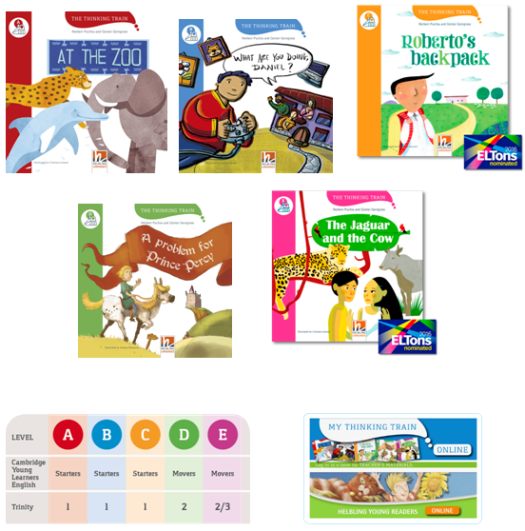
The Thinking Train. H. Puchta and G. Gerngross. (2015) Helbling Languages.
At the Zoo. ISBN 978-3-99045-303-5, pp32, What are you doing Daniel? ISBN 978-3-99045-303-2, pp32, Roberto’s backpack. ISBN 978-3-99045-304-9, pp32, A problem for Prince Percy. ISBN 978-3-99045-305-6, pp32, The jaguar and the cow. ISBN 978-3-99045-306-8, pp32. The Thinking Train is a new series of readers for young learners at the five levels of the YLE Cambridge Exam; they get progressively longer and more complex grammatically and lexically. The aim of the books is to supplement the course by providing extra language practice, as well as by developing children’s thinking skills. Each book has the same structure; first come pre-reading tasks which introduce or activate some of the language used in the story. Then comes the actual story told through text and pictures, after reading activities which involve writing, e.g. listening or drawing, and finally a ‘make and do’ section with ideas for projects like mask making, designing a perfect room or growing a plant. As children listen or read the story they have to interact by pointing to particular pictures, miming, answering personal questions relating to the story, commenting on the story, speaking to a classmate, acting out, thinking or drawing. The stories are interesting, and beautifully illustrated. I am sure the series will be very popular with teachers and learners. Additional resources for the readers are available online.
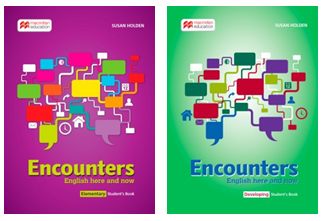
Encounters. English here and now. Elementary. Student’s book. S. Holden (this edition 2062) Macmillan. ISBN 978-1-786-32373-6, pp 93. Encounters. English here and now. Developing. Student’s book. S. Holden (this edition2016) Macmillan. ISBN 978-1-786-32375-0, pp 93. This course is aimed at professionals whose level of English is relatively low, and yet need to use English in their work place such as restaurants, hotels and other tourism environments. The course teaches present-day modern English for everyday communication, exposes the learners to authentic listening, and teaches vocabulary through language chunks rather than single words. Learners engage in practical communicative activities in the class; they develop not only their spoken competence but also help in building their self-confidence and flexibility. The author also plays a lot of attention to pronunciation work and clear delivery. The topics include among others the following areas: responding to requests in a bar, café or taxi, using and understanding numbers on the phone or on a bus, and explaining rules, behaviour and customs.
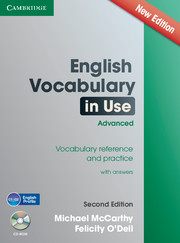
English Vocabulary in Use. Advanced. Vocabulary reference and practice with answers. Second Edition. M. McCarthy and F. O’Dell (2013) Cambridge. ISBN 978-1-107-63776-4, pp 304 + CD-ROM. The book belongs to a classic Cambridge University Press series of vocabulary practice resource books. The new edition includes among others predictable topics like work and study, people and relationships, leisure and lifestyle, and the environment. However, the units have been re-worked and based on the English Profile wordlists which feature the words or lexical items that need to be mastered at the C1 and C2 levels. Lexical items are presented and explained in meaningful context which make it clear how to use them. The learners are offered ample practice, both in the resource book and on the accompanying CD-ROM. There are also regular features highlighting and explaining frequent errors in using lexis. The CD-ROM offers extra exercises for each unit, and personalised printable tests. More information is available on
www.cambridge.org
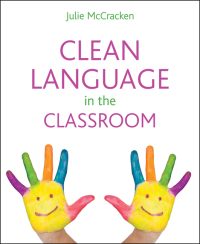
Clean Language in the Classroom. J. McCracken (2016) Crown House Publishing Limited. ISBN 978-184590860-7, pp 263. The book will be mostly welcome by all the teachers who are tired with resource books which offer ready ideas and photocopiable materials. This book looks at a field that is overlooked by teacher’s books, teacher’s manuals and teacher training courses, i.e. the intangible ways to improve communication and metacognition in the class. It looks at the ways teachers use language in the classroom, and helps them to make it ‘clean’ through step-by-step instructions, asking questions, modelling techniques and case studies. The outcome is a more communicative, supportive, collaborative, independent and reflective learning community. The areas covered by the book include a map of the field of clean language, how to apply clean language in the classroom, and how to develop it. Clean language in the classroom refers not only to language teaching, but also to teaching other subjects such as art, PE, music or design and technology. The appendices offer a number of photocopiable work sheets, which are ready to use. All teachers, not just language teachers will benefit greatly from the publication, and will help them revisit their classroom practices.
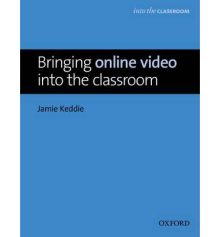
Bringing online video into the classroom. J. Keddie (2014) OUP. ISBN 978-0-19-442156-0, pp 160. This book is another book in the new OUP series: Into The Classroom, which is different from the old well established OUP series: Resource books for teachers. It is snappier than the old series. The books in the series are short practical guides aimed at teachers of 6-16 year olds who want to explore new teaching tools and techniques, or to become familiar with new educational policies and ways of implementing them in the classroom. The title in question focuses on how to use the wide range of online videos in class. There are suggestions how to find and use available video, and how to create and display your own videos. The book is divided into four parts: 1. components and competencies devoted to hardware and software, 2. video content for the classroom, 3. using video in the classroom, and 4. video cameras in and out of the classroom. The book is very informative and accessible, and will be of use to both a teacher who is not experienced in using videos and more experienced ones. To start with, teachers using the book can use films recommended in the book, before finding and adapting their own. When it comes to creating your own videos, the teacher will not find it hard at all, nor will the learners. Overall, the book is a fantastic booster to creativity. It will also be of great use to teacher trainers who deliver pre-service and in-service teacher training courses on using IT in the classroom.
You can take a look at some pages from the book at https://elt.oup.com/catalogue/
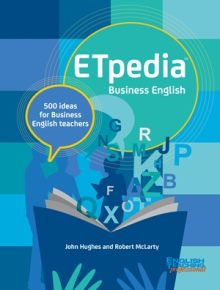
ETpedia. Business English. 500 ideas for Business English teachers. J. Hughes and R. McLarty (2016) Pavilion Publishing and Media. ISBN 978-0-911028-20-8, pp 174. This book is one of the first books in the new Pavilion and Media / English Teaching Professional series called ETpedia, a series of supplementary resources which contain teaching ideas, ready activities and tips. The book in question is divided into 6 sections. The introduction gives reasons for using this resource, suggestions how to use this resource, and introduces the authors who “between them (…) have over 50 years’ experience in Business English”. The section “What is business English?” is among others devoted to the nature of teaching business English as opposed to general English, and typical teaching contexts, including teaching in-company. The section on preparation and planning suggests ways of carrying out the learners’ needs analysis, assessing their level and planning the course. The next two sections give practical ideas for business topics like: workplaces, companies, money, finance or culture, and ideas for business communication skills such as how to practise speaking, correcting errors, giving feedback, sets of useful phrases and tips for telephone role plays. The last section looks at business language skills such as teaching grammar and vocabulary, pronunciation, using authentic texts and examinations for Business English. Overall the resource offers a wealth of materials and food for thought for teachers of Business English.
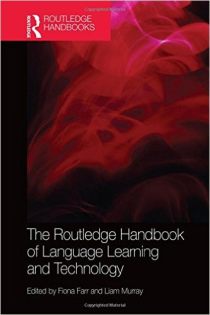
The Routledge Handbook of Language Learning and Technology. eds. F. Farr and L. Murray (2016) Routledge. ISBN 978-0-415-83787-3, pp 570. This book has appeared in the well-established Routledge Handbooks series. It is a collection of chapters on using technology in language teaching and learning. The chapters are grouped around the following areas: historical and conceptual contexts, core issues, interactive and collaborative technologies for language learning, corpora and data-driven learning, gaming and language learning, and purpose designed language learning resources. This impressive publication is exhaustive and maps out current knowledge about using technology for educational purposes, and I am sure will become a must-read for everyone interested in the subject, both those less experienced in the field, as well as those more informed.

Please check the Methodology & Language for Kindergarten Teachers course at Pilgrims website.
Please check the Methodology & Language for Primary Teachers course at Pilgrims website.
Please check the Methodology & Language for Secondary Teachers course at Pilgrims website.
Please check the Methodology for Teaching English Spoken Grammar course at Pilgrims website.
Please check the Teaching Advanced Students course at Pilgrims website.
Please check the Practical Uses of Technology in the Classroom course at Pilgrims website.
Please check the How to Teach Business Professionals at Pilgrims website.


|